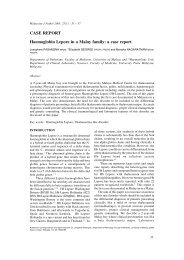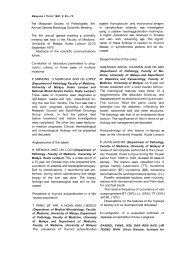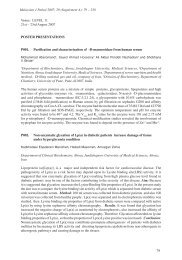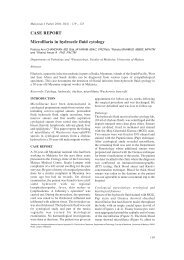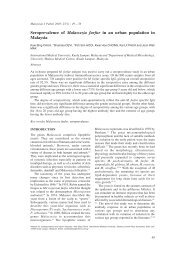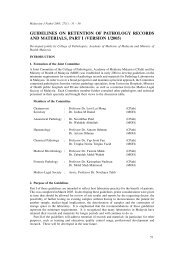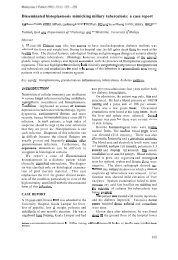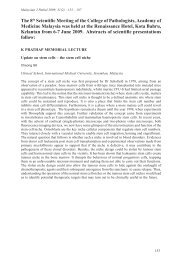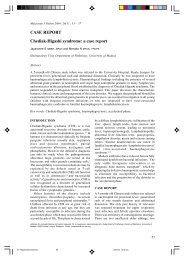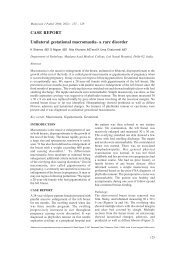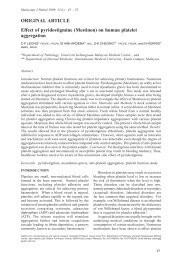Information for authors - The Malaysian Journal of Pathology
Information for authors - The Malaysian Journal of Pathology
Information for authors - The Malaysian Journal of Pathology
Create successful ePaper yourself
Turn your PDF publications into a flip-book with our unique Google optimized e-Paper software.
INFORMATION FOR AUTHORSTHE MALAYSIAN JOURNAL OF PATHOLOGY will publish manuscripts dealing with any aspect <strong>of</strong>PATHOLOGY including Chemical <strong>Pathology</strong>, Cytology, Experimental <strong>Pathology</strong>, Forensic <strong>Pathology</strong>,Haematology, Histopathology, Immunology, Medical Microbiology and Parasitology. In addition tocomplete papers, the <strong>Journal</strong> will publish case reports, brief communications (<strong>of</strong> up to 1000 words)and letters to the editor (up to 500 words). Papers are accepted on the understanding that they areoriginal. Papers are subjected to peer-review. Editorials and review articles are published by invitation.All manuscripts, including solicited materials, are subject to editorial revision.MANUSCRIPTS should con<strong>for</strong>m to the “Uni<strong>for</strong>m Requirements <strong>for</strong> Manuscripts Submitted toBiomedical <strong>Journal</strong>s” established by the International Committee <strong>of</strong> Medical <strong>Journal</strong> Editors, 1 whichare summarised below:PREPARATION OF MANUSCRIPTType or print on A4 size white paper with margins <strong>of</strong> at least 25 mm (1 inch). Type only on one side<strong>of</strong> the paper. Use double spacing throughout. Number pages consecutively, beginning with the titlepage.TITLE PAGE<strong>The</strong> title page should carry (a) the title <strong>of</strong> the article, (b) the names <strong>of</strong> all <strong>authors</strong> (with surnames incapitals) with their highest academic degree(s) (not more than two) and institutional affiliation; (c)the name <strong>of</strong> the department(s) and institutions(s) to which the work should be attributed; (d) the nameand address <strong>of</strong> the author responsible <strong>for</strong> correspondence about the manuscript and to whom requests<strong>for</strong> reprints should be directed; and (e) a short running title <strong>of</strong> no more than 40 characters (letters andspaces inclusive).ABSTRACT AND KEY WORDS<strong>The</strong> abstract should be not more than 250 words. <strong>The</strong> abstract should state the main purposes <strong>of</strong> thestudy, basic methodology, main findings (giving specific data and their statistical significance, ifpossible), and the principal conclusions. Emphasize new and important aspects <strong>of</strong> the study.Provide 3-10 key words or short phrases that will assist in cross-indexing your article. Use termsfrom the medical subject headings (MeSH) list <strong>of</strong> Index Medicus as far as possible.TEXT<strong>The</strong> text should be divided into the following sections: Introduction, Materials and Methods, Resultsand Discussion. Long articles may need sub-headings within some sections to clarify their content.Articles such as case reports, reviews, and editorials are likely to need other <strong>for</strong>mats, and <strong>authors</strong>should consult previous issues <strong>of</strong> the <strong>Journal</strong> <strong>for</strong> further guidance.IntroductionState the purpose <strong>of</strong> the article and summarise the rationale <strong>for</strong> the study. Give only pertinent references.Do not include data or conclusions from the work being reported.Materials and MethodsDescribe your selection <strong>of</strong> observational or experimental subjects (patients or laboratory animals,including controls). Identify the methods, special equipment or reagents (state manufacturer inparentheses), and procedures in sufficient detail to allow other workers to reproduce the results. Givereferences to established methods. Describe new or substantially modified methods. Identify all drugsand chemicals used, including generic name(s), dose(s), and routes(s) <strong>of</strong> administration. Specify thestatistical methods used to analyse data. Define statistical terms, abbreviations and symbols.67i
<strong>Malaysian</strong> J Pathol June 2008EthicsWhen reporting experiments on human subjects, indicate whether the procedures followed werein accordance with the ethical standards <strong>of</strong> the responsible committee on human experimentation(institutional or regional) and with the Helsinki Declaration <strong>of</strong> 1975, as revised in 2000. Do not usepatients’ names, initials, or hospital numbers, especially in illustrative material. When reportingexperiments on animals, indicate whether the institution’s or a national research council’s guide <strong>for</strong>,or any national law on, the care and use <strong>of</strong> laboratory animals was followed.ResultsPresent your results in logical sequence in the text, tables, and figures. Do not repeat in the text all thedata in the tables or figures; emphasize or summarise only important observations.DiscussionEmphasise the new and important aspects <strong>of</strong> the study and the conclusions that follow from them. Donot repeat in detail data or other material given in the Introduction or the Results sections. Include inthe Discussion section the implications <strong>of</strong> the findings and their limitations, including implications <strong>for</strong>future research. Relate the observations to other relevant studies.AcknowledgmentsSpecify (a) contributions that need acknowledging but do not justify <strong>authors</strong>hip, specifying the nature<strong>of</strong> their contribution (such as general support by a departmental Head, critical review <strong>of</strong> the paper, datacollection); (b) acknowledgments <strong>of</strong> technical help; (c) acknowledgments <strong>of</strong> financial and materialsupport, specifying the nature <strong>of</strong> the support; (d) relationships that may pose a conflict <strong>of</strong> interest; and(e) disclaimers, if any.REFERENCESNumber references consecutively in the order in which they are first mentioned in the text. Identifyreferences in text, tables, and legends by Arabic numerals in superscript. References cited only in tablesor in legends to figures should be numbered in accordance with the sequence established by the firstidentification in the text <strong>of</strong> the particular table or figure.<strong>The</strong> titles <strong>of</strong> journals should be abbreviated according to the style used in the Index Medicus.References should be verified by the author(s) against the original documents. Authors are responsible<strong>for</strong> the accuracy <strong>of</strong> their references.Examples <strong>of</strong> common <strong>for</strong>ms <strong>of</strong> references are given below. Further examples are available fromwww.nlm.nih.gov/citingmedicine(1) Standard journal article(List all <strong>authors</strong> when six or less; when seven or more, list only the first three <strong>authors</strong>followed by et al).Ellis IO, Coleman D, Wells C, et al. Impact <strong>of</strong> a national external quality assessmentscheme <strong>for</strong> breast pathology in the UK. J Clin Pathol. 2006; 59: 138-45.(2) Book with personal author(s)Modlin IM, Sachs G. Acid related diseases: biology and treatment. 2 nd ed. Philadelphia:Lippincott Williams & Wilkins; c2004. 522 p.(3) Book with Editor(s), compiler(s) as authorIzzo JL Jr, Black HR, editors. Hypertension primer: the essentials <strong>of</strong> high blood pressure.3rd ed. Philadelphia: Lippincott Williams & Wilkins; c2003. 532 p.ii68
INFORMATION FOR AUTHORS(4) Chapter in a bookPhillips SJ, Whisnant JP. Hypertension and stroke. In: Laragh JH, Brenner BM, editors.Hypertension: pathophysiology, diagnosis, and management. 2 nd ed. New York: RavenPress; 1995. p. 465-78.(5) Paper in a conference proceedingErasmus RT. Strategic planning <strong>for</strong> a pathology laboratory. In: Looi LM, editor. 24 thWorld Congress <strong>of</strong> <strong>Pathology</strong> and Laboratory Medicine; 2007 Aug 20-24; Petaling Jaya,Malaysia. Bologna (Italy): Monduzzi Editore, International Proceedings Division; c2007.p. 17-22.(6) Unpublished conference paperSelf CH. <strong>The</strong> impact <strong>of</strong> monoclonal antibodies on diagnosis and therapy. Paper presentedat: Meeting the challenges <strong>of</strong> globalisation and miniaturisation. 24 th World Congress <strong>of</strong><strong>Pathology</strong> and Laboratory Medicine; 2007 Aug 20-24; Petaling Jaya, Malaysia.(7) Forthcoming “in press” paperAlston RD, Tatevossian RG, McNally RJ, et al. Incidence and survival <strong>of</strong> childhoodLangerhans cell histiocytosis in Northwest England from 1954 to 1998. Pediatr BloodCancer. Forthcoming 2006.(8) Electronic materialTerauchi Y, Takamoto I, Kubota N, et al. Glucokinase and IRS-2 are required <strong>for</strong>compensatory beta cell hyperplasia in response to high-fat diet-induced insulin resistance.J Clin Invest [Internet]. 2007 Jan 2 [cited 2007 Jan 5];117(1):246-57. Available from:http://www.jci.org/cgi/content/full/117/1/246AMA: helping doctors help patients [homepage on the Internet]. Chicago: AmericanMedical Association; c1995-2007 [cited 2007 Feb 22]. Available from: http://www.amaassn.org/.TABLESType each table with double spacing on a separate sheet. Do not submit tables as photographs. Numbertables consecutively in the order <strong>of</strong> their first citation in the text and supply a brief title <strong>for</strong> each table.Avoid using internal vertical rules. Place all explanatory matter in the footnotes and explain all nonstandardabbreviations and symbols used. Statistical measures <strong>of</strong> variations, such as standard deviationsand standard error <strong>of</strong> the mean, are to be identified.FIGURES (ILLUSTRATIONS)Submit 2 complete sets <strong>of</strong> figures, as prints on good quality glossy paper. Symbols, arrows, or lettersused in photographs should contrast with the background. Cite each figure in the text in consecutiveorder. Each figure should have a label pasted on its back indicating the number <strong>of</strong> the figure, firstauthor’s name, and top <strong>of</strong> the figure. Do not bend or fold figures. Figures are normally printed in blackand white. Colour illustrations will be published only if the author pays <strong>for</strong> the extra cost.If photographs <strong>of</strong> people are used, either the subjects must not be identifiable or their pictures mustbe accompanied by written permission to use the photograph. If a figure has been published be<strong>for</strong>e,acknowledge the original source and submit written permission from the copyright holder to reproducethe material, except <strong>for</strong> documents in the public domain.69 iii
<strong>Malaysian</strong> J Pathol June 2008Legends <strong>for</strong> figuresType legends, double-spaced, on a separate page, with Arabic numerals corresponding to the figures.When symbols, arrows, numbers, or letters are used to identify parts <strong>of</strong> the illustrations, identifyand explain each one clearly in the legend. State the method <strong>of</strong> staining and magnification <strong>of</strong>photomicrographs.UNITS OF MEASUREMENTMeasurements <strong>of</strong> length, height, weight, and volume should be in metric units (metre, kilogram, or litre).Temperatures should be in degrees Celsius. All haematological and clinical chemistry measurementsshould be in metric measurements or International System <strong>of</strong> Units (SI).ABBREVIATIONS AND SYMBOLSUse only standard abbreviations. Avoid abbreviations in the title and abstract. <strong>The</strong> full term <strong>for</strong>which an abbreviation stands should precede its first use in the text unless it is a standard unit <strong>of</strong>measurement.MANUSCRIPT SUBMISSION<strong>The</strong> manuscript should preferably be sent in electronic <strong>for</strong>m via the <strong>Journal</strong> website at http://www.mjpath.org.my.Manuscripts must be accompanied by a covering letter. This must include (a) in<strong>for</strong>mation on prioror duplicate publication or submission elsewhere <strong>of</strong> any part <strong>of</strong> the work; (b) a statement <strong>of</strong> financialor other relationships that might lead to a conflict <strong>of</strong> interest; (c) a statement that the manuscript hasbeen read and approved by all the <strong>authors</strong>; and (d) the name, address, telephone and fax numbers ande-mail address <strong>of</strong> the corresponding author, who is responsible <strong>for</strong> communicating with the other <strong>authors</strong>about revisions and final approval <strong>of</strong> the pro<strong>of</strong>s. <strong>The</strong> letter should give any additional in<strong>for</strong>mationthat may be helpful to the editor, such as the type <strong>of</strong> article the manuscript represents and whether theauthor(s) will be willing to meet the cost <strong>of</strong> reproducing colour illustrations.Paper manuscriptsMail two copies <strong>of</strong> the manuscript, accompanied by an electronic version (Micros<strong>of</strong>t word <strong>for</strong>mat) ina CD, in a heavy-duty paper envelope to: <strong>The</strong> Editor, <strong>Malaysian</strong> <strong>Journal</strong> <strong>of</strong> <strong>Pathology</strong>, Department<strong>of</strong> <strong>Pathology</strong>, Faculty <strong>of</strong> Medicine, University <strong>of</strong> Malaya, 50603 Kuala Lumpur, Malaysia.REPRINTS, in excess <strong>of</strong> 25 free copies may be obtained at nominal rates if ordered either at the time<strong>of</strong> submitting the manuscript or when returning galley pro<strong>of</strong>s.REFERENCESl. International Committee <strong>of</strong> Medical <strong>Journal</strong> Editors. Uni<strong>for</strong>m Requirements <strong>for</strong> ManuscriptsSubmitted to Biomedical <strong>Journal</strong>s: Writing and Editing <strong>for</strong> Biomedical Publication [Internet].International Committee <strong>of</strong> Medical <strong>Journal</strong> Editors; 2007 [modified 2007 October; cited 2008February 22]. Available from: http://www.icmje.org/icmje.pdfiv70




